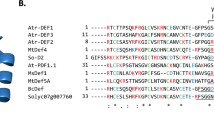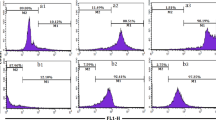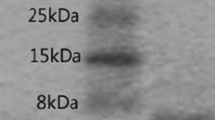Abstract
A novel antimicrobial peptide named NP-6 was identified in our previous work. Here, the mechanisms of the peptide against Escherichia coli (E. coli) were further investigated, as well as the peptide’s resistance to temperature, pH, salinity, and enzymes. The transmission electron microscopy (TEM), confocal laser scanning microcopy (CLSM), and flow cytometric (FCM) analysis, combined with measurement of released K+, were performed to evaluate the effect of NP-6 E. coli cell membrane. The influence of NP-6 on bacterial DNA/RNA and enzyme was also investigated. The leakage of K+ demonstrated that NP-6 could increase the permeability of E. coli cell membrane. The ATP leakage, FCM, and CLSM assays suggested that NP-6 caused the disintegration of bacterial cell membrane. The TEM observation indicated that NP-6 could cause the formation of empty cells and debris. Besides, the DNA-binding assay indicated that NP-6 could bind with bacterial genomic DNA in a way that ethidium bromide (EB) did, and suppress the migration of DNA/RNA in gel retardation. Additionally, NP-6 could also affect the activity of β-galactosidase. Finally, the effect of different surroundings such as heating, pH, ions, and protease on the antimicrobial activity of NP-6 against E. coli was also investigated. Results showed that the peptide was heat stable in the range of 60~100 °C and performed well at pH 6.0~8.0. However, the antimicrobial activity of NP-6 decreased significantly in the presence of Mg2+/Ca2+, and after incubation with trypsin/proteinase K. The results will provide a theoretical support in the further application of NP-6.








Similar content being viewed by others
References
Aerts AM, Franåois IEJA, Cammue BPA, Thevissen K (2008) Review the mode of antifungal action of plant , insect and human defensins. Cell Mol Life Sci 65:2069–2079. https://doi.org/10.1007/s00018-008-8035-0
Ageitos JM, Sánchez-pérez A, Calo-mata P, Villa TG (2017) Antimicrobial peptides ( AMPs ): ancient compounds that represent novel weapons in the fight against bacteria. Biochem Pharmacol 133:117–138. https://doi.org/10.1016/j.bcp.2016.09.018
Anderson RC, Hancock REW, Yu PL (2004) Antimicrobial activity and bacterial-membrane interaction of ovine-derived Cathelicidins. Antimicrob Agents Chemother 48:673–676. https://doi.org/10.1128/AAC.48.2.673
Auliffe OMC, Ryan MP, Ross RP, Hill C, Breeuwer P, Abee T (1998) Lacticin 3147 , a broad-spectrum bacteriocin which selectively dissipates the membrane potential. Appl Environ Microbiol 64:439–445
Branco P, Francisco D, Monteiro M, Almeida MG, Caldeira J, Arneborg N, Prista C, Albergaria H (2017) Antimicrobial properties and death-inducing mechanisms of saccharomycin, a biocide secreted by Saccharomyces cerevisiae. Appl Microbiol Biotechnol 101:159–171. https://doi.org/10.1007/s00253-016-7755-6
da Costa JP, Cova M, Ferreira R, Vitorino R (2015) Antimicrobial peptides: an alternative for innovative medicines? Appl Microbiol Biotechnol 99:2023–2040. https://doi.org/10.1007/s00253-015-6375-x
Drin G, Antonny B (2010) Amphipathic helices and membrane curvature. FEBS Lett 584:1840–1847. https://doi.org/10.1016/j.febslet.2009.10.022
Du H, Yang J, Lu Z, Bie X, Zhao H, Zhang C, Lu F (2018) Purification , characterization , and mode of action of plantaricin GZ1-27 , a novel bacteriocin against Bacillus cereus. J Agric Food Chem 66:4716–4724. https://doi.org/10.1021/acs.jafc.8b01124
Gottschalk S (2017) The interaction of antimicrobial peptides with the membrane and intracellular targets of Staphylococcus aureus investigated by ATP leakage, DNA-binding analysis, and the expression of a LexA-controlled gene, recA. In: Antimicrobial Peptides. Humana Press, New York, pp 297–305
Guilhelmelli F, Vilela N, Albuquerque P, Derengowski LS (2013) Antibiotic development challenges : the various mechanisms of action of antimicrobial peptides and of bacterial resistance. Front Microbiol 4:1–12. https://doi.org/10.3389/fmicb.2013.00353
Hancock REW (2011) Multifunctional cationic host defence peptides and their clinical applications. Cell Mol Life Sci 68:2161–2176. https://doi.org/10.1007/s00018-011-0710-x
Hancock REW, Sahl H (2006) Antimicrobial and host-defense peptides as new anti-infective therapeutic strategies. Nat Biotechnol 24:1551–1557. https://doi.org/10.1038/nbt1267
Hirakura Y, Kobayashi S, Matsuzaki K (2002) Specific interactions of the antimicrobial peptide cyclic h -sheet tachyplesin I with lipopolysaccharides. Biochim Biophys Acta - Biomembr 1562:32–36. https://doi.org/10.1016/S0005-2736(02)00358-9
Hou XY, Li SS, Luo QY, Shen GH, Wu HJ, Li ML, Liu XY, Chen AJ, Ye M, Zhang ZQ (2019) Discovery and identification of antimicrobial peptides in Sichuan pepper (Zanthoxylum bungeanum Maxim) seeds by peptidomics and bioinformatics. Appl Microbiol Biotechnol 103:1–12. https://doi.org/10.1007/s00253-018-09593-y
Hsu C, Chen C, Jou M, Lee AY, Lin Y, Yu Y, Huang W, Wu S (2005) Structural and DNA-binding studies on the bovine antimicrobial peptide , indolicidin : evidence for multiple conformations involved in binding to membranes and DNA. Nucleic Acids Res 33:4053–4064. https://doi.org/10.1093/nar/gki725
Jiang T, Wu H, Dong X, Chen S, Shen G, Zhang Z (2015) Isolation and purification of antimicrobial peptides from prickly ash (Zanthoxylum bungeanum Maxim) seed protein. China Oils Fats 40:20–24
Kragol G, Lovas S, Varadi G, Condie BA, Hoffmann R, Otvos L (2001) The antibacterial peptide pyrrhocoricin inhibits the ATPase actions of DnaK and prevents chaperone-assisted protein folding. Biochemistry 40:3016–3026. https://doi.org/10.1021/bi002656a
Kumar P, Kizhakkedathu JN, Straus SK (2018) Antimicrobial peptides : diversity , mechanism of action and strategies to improve the activity and biocompatibility in vivo. Biomolecules 8:4–28. https://doi.org/10.3390/biom8010004
LePecq JB, Paoletti C (1967) A fluorescent complex between ethidium and nucleic acids bromide. J Mol Biol 27:87–106. https://doi.org/10.1016/0022-2836(67)90353-1
Li Y, Xiang Q, Zhang Q, Huang Y, Su Z (2012) Peptides overview on the recent study of antimicrobial peptides : origins , functions , relative mechanisms and application. Peptides 37:207–215. https://doi.org/10.1016/j.peptides.2012.07.001
Li L, Shi Y, Cheserek MJ (2013) Antibacterial activity and dual mechanisms of peptide analog derived from cell-penetrating peptide against Salmonella typhimurium and Streptococcus pyogenes. Appl Microbiol Biotechnol 97:1711–1723. https://doi.org/10.1007/s00253-012-4352-1
Li W, Tailhades J, O’Brien-Simpson NM, Separovic F, Otvos L, Hossain MA, Wade JD (2014) Proline-rich antimicrobial peptides: potential therapeutics against antibiotic-resistant bacteria. Amino Acids 46:2287–2294
Li L, Sun J, Xia S, Tian X (2016) Mechanism of antifungal activity of antimicrobial peptide APP , a cell-penetrating peptide derivative , against Candida albicans : intracellular DNA binding and cell cycle arrest. Appl Microbiol Biotechnol 100:3245–3253. https://doi.org/10.1007/s00253-015-7265-y
Liu G, Song Z, Yang X, Gao Y, Wang C (2016) Antibacterial mechanism of bifidocin A , a novel broad-spectrum bacteriocin produced by Bifidobacterium animalis BB04. Food Control 62:309–316. https://doi.org/10.1016/j.foodcont.2015.10.033
Lu C, Wang H, Lv W, Lou Z (2011) Antibacterial properties of anthraquinones extracted from rhubarb against Aeromonas hydrophila. Fish Sci 77:375–384. https://doi.org/10.1007/s12562-011-0341-z
Mahlapuu M, Håkansson J, Ringstad L, Björn C (2016) Antimicrobial peptides : an emerging category of therapeutic agents. Front Cell Infect Microbiol 6:1–12. https://doi.org/10.3389/fcimb.2016.00194
Malmsten M (2016) Interactions of antimicrobial peptides with bacterial membranes and membrane components. Curr Top Med Chem 16:16–24
Miao J, Zhou J, Liu G, Chen F, Chen Y, Gao X, Dixon W, Song M, Xiao H, Cao Y (2016) Membrane disruption and DNA binding of Staphylococcus aureus cell induced by a novel antimicrobial peptide produced by Lactobacillus paracasei subsp . tolerans FX-6. Food Control 59:609–613. https://doi.org/10.1016/j.foodcont.2015.06.044
Nakajima H, Amano W, Fukuhara A, Ihara H, Azuma Y, Tajima H (2009) Glyceraldehyde-3-phosphate dehydrogenase aggregate formation participates in oxidative stress-induced cell death. J Biol Chem 284(49):34331–34341. https://doi.org/10.1074/jbc.M109.027698
Nguyen LT, Haney EF, Vogel HJ (2011) The expanding scope of antimicrobial peptide structures and their modes of action. Trends Biotechnol 29:464–472. https://doi.org/10.1016/j.tibtech.2011.05.001
Qian L, Xiao H, Zhao G, He B (2011) Synthesis of modified guanidine-based polymers and their antimicrobial activities revealed by AFM and CLSM. Appl Mater interfaces 3:1895–1901. https://doi.org/10.1021/am200094u
Rončević T, Vukičević D, Krce L, Benincase M, Aviani I, Maravić A, Tossi A (2019) Selection and redesign for high selectivity of membrane-active antimicrobial peptides from a dedicated sequence/function database. BBA - Biomembr 1861:827–834. https://doi.org/10.1016/j.bbamem.2019.01.017
Seo J-K, Lee MJ, Go H-J, Park TH, Park NG (2012) Purification and characterization of YFGAP, a GAPDH-related novel antimicrobial peptide, from the skin of yellowfin tuna, Thunnus albacares. Fish Shellfish Immunol 33:743–752. https://doi.org/10.1016/j.fsi.2012.06.023
Seo J, Jeong M, Go H, Jun Y, Gyu N (2014) Antimicrobial function of the GAPDH-related antimicrobial peptide in the skin of skipjack tuna , Katsuwonus pelamis. Fish Shellfish Immunol 36:571–581. https://doi.org/10.1016/j.fsi.2014.01.003
Shi W, Li C, Li M, Zong X, Han D, Chen Y (2016) Antimicrobial peptide melittin against Xanthomonas oryzae pv. oryzae, the bacterial leaf blight pathogen in rice. Appl Microbiol Biotechnol 100:5059–5067. https://doi.org/10.1007/s00253-016-7400-4
Sik W, Ki H, Young K, Am S, Soo Y, Hee I (2006) Antifungal activity of synthetic peptide derived from halocidin, antimicrobial peptide from the tunicate, Halocynthia aurantium. FEBS Lett 580:1490–1496. https://doi.org/10.1016/j.febslet.2006.01.041
Silva A, Almeida B, Sampaio-marques B, Reis MIR, Ohlmeier S, Rodrigues F (2011) Glyceraldehyde-3-phosphate dehydrogenase ( GAPDH ) is a speci fi c substrate of yeast metacaspase. BBA - Mol Cell Res 1813:2044–2049. https://doi.org/10.1016/j.bbamcr.2011.09.010
Tang W, Xie Q, Guan J, Jin S, Zhao Y (2014a) Phytochemical profiles and biological activity evaluation of Zanthoxylum bungeanum Maxim seed against asthma in murine models. J Ethnopharmacol 152:444–450. https://doi.org/10.1016/j.jep.2014.01.013
Tang W, Zhang H, Wang L, Qian H (2014b) New cationic antimicrobial peptide screened from boiled-dried anchovies by immobilized bacterial membrane liposome chromatography. J Agric Food Chem 62:1564–1571. https://doi.org/10.1021/jf4052286
Tang W, Yuan H, Zhang H, Wang L, Qian H, Qi X (2015) An antimicrobial peptide screened from casein hydrolyzate by Saccharomyces cerevisiae cell membrane af fi nity method. Food Control 50:413–422. https://doi.org/10.1016/j.foodcont.2014.09.030
Tao R, Tong Z, Lin Y, Xue Y, Wang W, Kuang R, Wang P, Tian Y, Ni L (2011) Antimicrobial and antibiofilm activity of pleurocidin against cariogenic microorganisms. Peptides 32:1748–1754. https://doi.org/10.1016/j.peptides.2011.06.008
Wagener J, Schneider JJ, Baxmann S, Kalbacher H, Borelli C, Nuding S, Küchler R, Wehkamp J, Kaeser MD, Mailänder-Sanchez D, Braunsdorf C, Hube B, Schild L, Forssmann WG, Korting HC, Liepke C, Schaller M (2013) A peptide derived from the highly conserved protein gapdh is involved in tissue protection by different antifungal strategies and epithelial immunomodulation. J Invest Dermatol 133:144–153. https://doi.org/10.1038/jid.2012.254
Wang G, Li X, Wang Z (2016) APD3: The antimicrobial peptide database as a tool for research and education. Nucleic Acids Res 44:D1087–D1093. https://doi.org/10.1093/nar/gkv1278
Wu H, Jiang T, Dong X, Shen G, Li S, Zhang Z (2016) Purification and characterization of angiotensin-I converting enzyme inhibitory peptides from prickly ash (Zanthoxylum bungeanum Maxim) seed protein hydrolysates. Int J Food Eng 12:333–342. https://doi.org/10.1515/ijfe-2015-0091
Xia L, You J, Li G (2011) Compositional and antioxidant activity analysis of Zanthoxylum bungeanum seed oil obtained by supercritical CO2 fluid extraction. J Am Oil Chem Soc 88:23–32. https://doi.org/10.1007/s11746-010-1644-4
Yang Q, Cao W, Zhou X, Cao W, Xie Y, Wang S (2014) Anti-thrombotic effects of α-linolenic acid isolated from Zanthoxylum bungeanum Maxim seeds. BMC Complement Altern Med 14:1–8. https://doi.org/10.1186/1472-6882-14-348
Zhang M, Li M, Sun L (2014) NKLP27 : A teleost NK-lysin peptide that modulates immune response , induces degradation of bacterial DNA , and inhibits bacterial and viral infection. PLoS One 9:e106543. https://doi.org/10.1371/journal.pone.0106543
Zhang M, Wang J, Zhu L, Li T, Jiang W, Zhou J (2017) Zanthoxylum bungeanum Maxim . ( Rutaceae ): a systematic review of its traditional uses , botany , phytochemistry , pharmacology , pharmacokinetics , and toxicology. Int J Mol Sci 18:2172. https://doi.org/10.3390/ijms18102172
Funding
This study received financial assistance from the Scientific Fund of the Application Fundamental Project (2016-JY-0118) and Key Project of Research and Development Program (18ZDYF1175), Science and Technology Department of Sichuan Province.
Author information
Authors and Affiliations
Corresponding author
Ethics declarations
Conflict of interest
The authors declare that they have no conflict of interest.
Ethical approval
This article does not contain any studies with human participants or animals by any of the authors.
Additional information
Publisher’s note
Springer Nature remains neutral with regard to jurisdictional claims in published maps and institutional affiliations.
Rights and permissions
About this article
Cite this article
Hou, X., Feng, C., Li, S. et al. Mechanism of antimicrobial peptide NP-6 from Sichuan pepper seeds against E. coli and effects of different environmental factors on its activity. Appl Microbiol Biotechnol 103, 6593–6604 (2019). https://doi.org/10.1007/s00253-019-09981-y
Received:
Revised:
Accepted:
Published:
Issue Date:
DOI: https://doi.org/10.1007/s00253-019-09981-y




